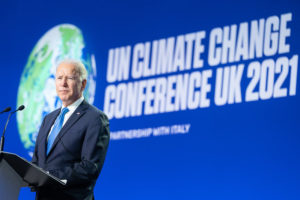
President Joe Biden delivers remarks at the Accelerating Net Zero Innovation event, Tuesday, November 2, 2021, during the COP26 U.N. Climate Change Conference in Glasgow, Scotland. (Official White House Photo by Adam Schultz)
Help for Self-Respecting Climate Alarmists
With the Supreme Court’s decision in West Virginia v. EPA on June 30, the bureaucracies in the “climate” space, along with all the environmental activists, have been thrown into a tizzy, writes Francis Menton.
The Supreme Court just declared that the bureaucracies have no power to fundamentally transform the use of energy in the economy without a clear direction from Congress, which on the climate issue cannot be found in existing statutes. And it has become clear that no further such statutory direction is likely to emerge from Congress before the mid-term elections in November.
After November, changes in the make-up of Congress will probably make further such legislation even less likely, if not completely off the table for years if not decades. So what is a self-respecting climate alarmist to do?
How to Amass Special Powers
With that declaration, the statutory gap could perhaps be filled by another whole category of laws providing special powers in the event of a declaration of “emergency.” The calls for President Biden to make such a declaration have been everywhere since the Supreme Court’s decision at the end of June.
A “Strong Letter” (from a gaggle of Democrat senators to Biden on July 20)
- Edward Markey, Elizabeth Warren (MA)
- Cory Booker (NJ)
- Sheldon Whitehouse (RI)
- Brian Schatz (HI)
- Martin Heinrich NM)
- Alex Padilla (CA)
- Jeff Merkley (OR)
- Bernie Sanders (VT)
Declaring the climate crisis a national emergency under the NEA would unlock powers to rebuild a better economy with significant, concrete actions. . . . Under the NEA, you could redirect spending to build out renewable energy systems on military bases, implement large-scale clean transportation solutions and finance distributed energy projects to boost climate resiliency. All of these actions would employ Americans in new and emerging industries while securing American leadership in global markets.
There were many more examples of the same demand from all the usual suspects, continues the Manhattan Contrarian.
Indeed, there was lots of talk that Biden was going to make the big declaration on Wednesday, when he went to Massachusetts to give a speech at a closed coal-fired power plant. He somehow stopped just short of the formal “emergency” declaration, but took the occasion to emit the usual clichés about the impending climate apocalypse, including liberal use of the term “emergency” itself. Excerpt:
“Climate change is literally an existential threat to our nation and to the world,” Mr. Biden said. . .. “This is an emergency, an emergency, and I will look at it that way.”
What Declaring an Emergency Means
The idea is that there are plenty of existing statutes out there granting the Executive powers of various sorts in the event of such an “emergency,” provided that there had been a formal declaration of it. Thus arguably there would be a way around the lack of clear statutory authority that sank the EPA’s power plant regulations in the West Virginia case.
From The Nation on July 21; a rundown of some of the powers that “the Executive could purport to exercise in the event of such a declaration with respect to the climate:”
[S]uch a declaration would enable the Biden administration to access funding from the Federal Emergency Management Agency’s Building Resilient Infrastructure and Communities program for combating the impacts of heat waves, extreme weather events, and natural disasters and could enable faster implementation of critical mitigation strategies. An official climate emergency announcement could also allow the Biden administration to curtail crude oil exports and stop offshore drilling through laws and exemptions related to national security and energy development. The Biden administration could access financial support for clean energy infrastructure through FEMA and the Stafford Disaster Relief and Emergency Assistance Act, and it could cut energy costs for families by supporting domestic offshore wind projects, helping to facilitate an affordable clean energy transition.
But Here’s the Problem!
There is no sense in which the climate is an “emergency” within the ordinary meaning of that word in the English language. Predictions by climate models of a few degrees of temperature rise over the next century are the opposite of an “emergency.” Indeed, the statutes granting various “emergency” powers to the Executive all deal with the question of time periods too short to give the Congress time to enact legislation appropriate to the situation at hand. That circumstance is the opposite of what we have with the climate.
How Long for an Emergency?
An “emergency” must be declared, to last for — how long? A hundred years? During which time, the bureaucrats can issue whatever orders they want, and spend whatever funds they want, all in the name of saving the planet. None of which will or can have any effect on the 85% (and growing) of world carbon emissions that come from outside the U.S. and which the U.S. government cannot affect in any way.
If you’re willing to fight for Main Street America, click here to sign up for the Richardcyoung.com free weekly email.





